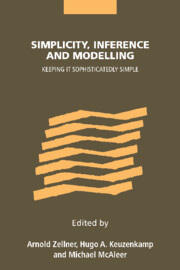Book contents
- Frontmatter
- Contents
- List of figures
- List of tables
- List of contributors
- 1 The enigma of simplicity
- PART I The importance of simplicity
- 2 What is the problem of simplicity?
- 3 Science seeks parsimony, not simplicity: searching for pattern in phenomena
- 4 A macroeconomic approach to complexity
- 5 The new science of simplicity
- 6 What explains complexity?
- 7 Occam's bonus
- PART II Simplicity in theory and practice
- Index
2 - What is the problem of simplicity?
Published online by Cambridge University Press: 22 September 2009
- Frontmatter
- Contents
- List of figures
- List of tables
- List of contributors
- 1 The enigma of simplicity
- PART I The importance of simplicity
- 2 What is the problem of simplicity?
- 3 Science seeks parsimony, not simplicity: searching for pattern in phenomena
- 4 A macroeconomic approach to complexity
- 5 The new science of simplicity
- 6 What explains complexity?
- 7 Occam's bonus
- PART II Simplicity in theory and practice
- Index
Summary
Scientists sometimes choose between rival hypotheses on the basis of their simplicity. Non-scientists do the same thing; this is no surprise, given that the methods used in science often reflect patterns of reasoning that are at work in everyday life. When people choose the simpler of two theories, this ‘choosing’ can mean different things. The simpler theory may be chosen because it is aesthetically more pleasing, because it is easier to understand or remember, or because it is easier to test. However, when philosophers talk about the ‘problem of simplicity’, they are usually thinking about another sort of choosing. The idea is that choosing the simpler theory means regarding it as more plausible than its more complex rival.
Philosophers often describe the role of simplicity in hypothesis choice by talking about the problem of curve-fitting. Consider the following experiment. You put a sealed pot on a stove. The pot has a thermometer attached to it as well as a device that measures how much pressure the gas inside exerts on the walls of the pot. You then heat the pot to various temperatures and observe how much pressure there is in the pot. Each temperature reading with its associated pressure reading can be represented as a point in the coordinate system depicted below (figure 2.1). The problem is to decide what the general relationship is between temperature and pressure for this system, given the data.
- Type
- Chapter
- Information
- Simplicity, Inference and ModellingKeeping it Sophisticatedly Simple, pp. 13 - 31Publisher: Cambridge University PressPrint publication year: 2002
- 10
- Cited by



